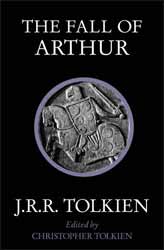|
Click here to return to the main site. Book Review
J. R. R. Tolkien (1892 – 1973) may well be better known as the author of The Silmarillion, The Hobbit and The Lord of the Rings, but he also had a very distinguished academic career, including holding an academic seat in Oxford University. Much of the work which he started completed or, indeed failed to complete, have been, over the years, published by his son Christopher Tolkien. The Fall of Arthur (2014. 233 Pages) by J. R. R. Tolkien, edited by Christopher Tolkien, presents Tolkien’s alliterative poem for the first time in paperback form. The poem itself runs to nearly a thousand verses, which composes only forty pages of the completed book. The poem takes it inspiration from some of the oldest versions of the Arthurian legend, placing the story in an early medieval period, where the decaying Roman Empire continues to exist. The Arthurian legend comes in many flavours and Tolkien’s incomplete poem does not include aspects which many may think canon to the story. There is no quest for the Holy Grail, rather the poem strips away much of the mystic elements of the story, leaving one which portrays Arthur as a strong king of the Britons, who having gone to war on the continent, is betrayed by Mordred and returns to claim back both his wife and his lands. Although incomplete, the poem was sufficiently advanced in the nineteen thirties for him to send to colleagues for criticism and although met with much praise, other literary works took precedence. Not all was lost and, as Christopher is able to demonstrate, some ideas and imagery crossed over from Arthur to the Silmarillion. The poem is written in an alliterative style, common to old Germanic verse and the English epic poem Beowulf, which Tolkien produced the definitive version. To put it simply, it does not rhyme in the traditional sense, rather it is built up via patterns and particular stresses on the words. Fear not if this makes little sense as there is a whole section of the book dedicated to the explanation and discussion of this form of early poetry. Following on from the bulk of the poem which still exist, Christopher then takes a look at how his father’s version of the fall of Arthur compares to the main literary sources, Mallory’s Morte Arthur, the French Mort Artu, Geoffrey of Monmouth Historia Regum Britanniae and the alliterative Morte Arthure as well as a number of ancillary works which are relevant to the Arthurian myth. Overall a good scholarly work which is both its strength and its weakness with large sections of Anglo-Saxon poetry reproduced to support the central discussion, like reading Chaucer without a translation. Who would want to read the book? I suppose anyone interested in either the poetry or Tolkien’s unpublished works. At times it was a little heavy going but well worth the effort. 9 Charles Packer Buy this item online
|
|---|


